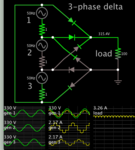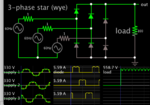- Joined
- Jan 22, 2008
- Messages
- 52,362
- Helped
- 14,743
- Reputation
- 29,768
- Reaction score
- 14,086
- Trophy points
- 1,393
- Location
- Bochum, Germany
- Activity points
- 297,824
Boost topologies have been suggest previously in this thread. I understand that your bias towards separate single-phase PFC units is related to predesigned solutions from TI. Industry standard solutions are three phase PFC converters like Vienna rectifier or bidirectional active front end.What do you think about the boost topology?
- - - Updated - - -
I don't agree that "synchronise with the AC-line" is the key point for different topologies. It's more generally the ability to sink a sinusoidal current independently in each phase. It's e.g. not possible if the mains current is routed through a three-phase bridge.




